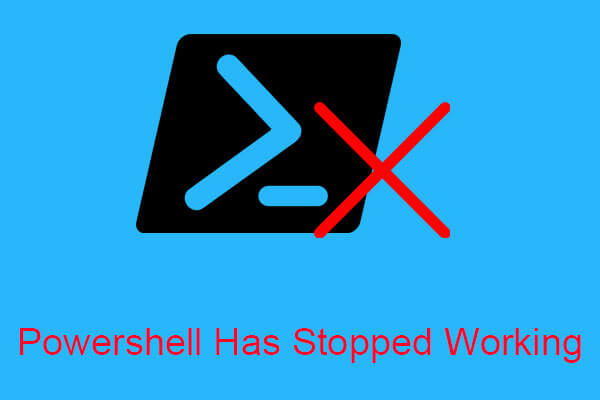In this modern digital world, everyone is striving toward automation. To an administrator, repetitively performing the same tasks might become monotonous, reducing efficiency and leading to error. Windows PowerShell is a scripting and command-line tool in Windows operating system through which you will be able to automate such mundane tasks. Microsoft has developed this, and the users can use it to run script automation, batch command, etc. If you want to launch Windows PowerShell, Search for it in the Windows Search, and select PowerShell. PowerShell is a reliable tool. However, lately, some users have been experiencing issues with PowerShell. Many people complained of PowerShell not working, and a popup window appears on the screen showing an error message. Users can see error messages when they wish to launch Windows PowerShell. Some messages are:-
“This file does not contain an application associated with it to perform this action. You need to install an application, or if the app is already installed, you need to develop an association in the Settings page of the Default Apps.
PowerShell Not working/Stopped working
The operation is being canceled because of restrictions in effect on the computer. You need to contact your system administrator”
If you view any of the above error messages once you launch Windows PowerShell, we have explained some solutions in the article that might help you fix the PowerShell Not working issue.
Possible causes of the error
Below mentioned are the most common causes which may prevent PowerShell from working properly:
Buggy Windows version
Background service conflict
Corrupt/ Misconfigured user account
Corrupt PowerShell files
Misconfigured group policies
PowerShell is disabled
No admin privileges
Procedures to fix PowerShell not working issue
Enable the Windows PowerShell
The error can pop up simply because Windows PowerShell might have been disabled. So, users can easily tackle the problem by tweaking some settings mentioned below:
At first, in the Start Menu search bar, you have to type Turn Windows Features off or on, and then you need to choose the best match
Then find the option Windows PowerShell and click the drop-down menu
Next, check every Windows PowerShell box and press OK.
The Windows Features screen has to be closed. Finally, to apply these changes, restart your device.
With Administrative Privileges, run the Windows PowerShell
It might help if Windows PowerShell is opened with administrative privileges. Let us check out this:
Foremost, in the Start Menu search bar, type Task Manager and then select the Best match
From the top-left corner, click the File tab and select the option Run new task
Now, type PowerShell and click on the box With administrative privileges create this task.
Finally, to open an elevated window of PowerShell, click OK
Use a different Microsoft account
In some cases, this problem can affect only the account you currently use. So, the best way of handling the problem is using a different account from Microsoft. If you are not a holder of any Microsoft account, you can consider creating an account if the issue gets solved. Here’s how you will be able to sign in or create a Microsoft account:
First, click on the Windows key and choose the Settings option
Next, select Accounts and click on Email and accounts on the left side.
On your right-hand side, click on the option Add a Microsoft Account, and then you need to fill in your details
Go through the on-screen instructions. Now, try opening the PowerShell tool.
If your issue still persists, you are most likely dealing with some system issues. If so, we will provide some fixes to resolve the issue
Get rid of the suspicious third-party programs
Some faulty third-party apps can cause this error. However, you can face some difficulty locating the corrupted app, which is causing the trouble. If you perform a clean reboot, this might help you out. Once you have located the faulty app, you can go for it’s update or get rid of it. If you decide to delete the app causing problem, we recommend you use a reliable third-party uninstaller. This will assist you in getting rid of the residual files that can stay and cause other problems.
Try built-in troubleshooters
There are some built-in troubleshooters that you may use in different situations. Let us assume that an error causes this issue in the system maintenance, then the system maintenance troubleshooter can help. So, let us get into the particulars of how you can run this troubleshooter to tackle this issue at hand.
In the start menu of the search bar, type Control Panel and then select the Best match
From the drop-down menu, click the View by and then select Small icons
From the menu items, click Then, your job is to scroll down and choose the option System and Security
Next, click on the option System Maintenance
Click Advanced, and then click on the box Apply repairs automatically
Finally, click on Next and follow the steps on the screen
If you see that the issue persists, we suggest you try another approach. It can be a problem related to hardware, then let us see how the devices and hardware troubleshooter might help:
For opening the Systems Settings, press Win + I
Choose Update and Security and on your left-hand side, click Troubleshoot
Find and click on the option Hardware and Device troubleshooter.
Then press the button Run the troubleshooter, and follow the steps on the screen.
Perform a System scan
The error can be caused because of faulty system files. So, in this case, you will be required to perform a scan of your system and then repair those problematic files. When it comes to repairing and scanning files, you must rely on the SFC, DISM, and Check Disk tools. Now let us explain how to run a scan of the Check disk:-
The Start menu search bar has to be opened, and then type Command Prompt
On the option Command Prompt, right-click and choose Run as administrator
Type the command chkdsk C:/f and press enter to run a Check Disk scan
The C: command has to be replaced with the proper drive letter when your Windows OS has been installed on a different drive. Next, follow the below-mentioned steps for running the DISM tool:-
An Elevated Command Prompt has to be opened following the above steps
Then type the command DISM/Online/Cleanup-Image/ScanHealth and press Enter
Now type the command DISM/Online/Cleanup-Image/RestoreHealth and press Enter
Restart your device once the scanning is complete. Now follow the steps mentioned below and run an SFC scan:
According to the previous steps, open the Elevated Command Prompt
Then type the command sfc/scannow and press Enter
When the scan is over, your device has to be restarted.
Restore your Windows device
To store your device with the tool System, restore might help. The feature system restore helps in undoing any latest change that can cause system errors, which can help you eliminate the bugs that might have interfered with PowerShell. For this:
In the search menu of the Start bar, type Control Panel and select the Best Match
From the drop-down menu, click the View by and select Small icons
Now scroll down and select the Recovery option
Next, click on the option Open System Restore and then to continue, click Next
From the options, select a restore point and press Next and go through the on-screen steps
Wrapping up
The error “PowerShell not working” can be quite annoying, particularly when you are unaware of what is causing it. Fortunately, we have come up with some methods to help you get rid of this problem easily. As a last resort, resetting Windows back to it’s factory settings might help. Before proceeding, ensure to back up your device. Now, you can automate your most favorite tasks with PowerShell.
Experiencing difficulties with your Device, check out our “How To” page on how to resolve some of these issues.














